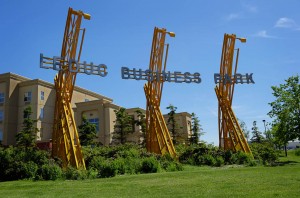
Canada Prepares for Energy Sector Challenges
24 Feb, 2015
Interview by Rachel Duran
Plunging oil prices create varied economic outcomes for the Western Canadian provinces.
Editor’s Note: This interview was conducted January 5, 2015. For the latest information in regard to the forecast for the Canadian economy, visit www.conferenceboard.ca.
Business investments into Canada have been weak the last couple of years, and 2015 was shaping up to be the year when the investment climate turned around. However, a continued decline in the price of oil, to below $48 per barrel on January 6, has affected the forecast.
How will the changes impact the economies of the western Canadian provinces of British Columbia, Alberta, Saskatchewan and Manitoba, particularly the activity in the Alberta oil sands? British Columbia’s and Manitoba’s economies feature many positives, while Saskatchewan’s agriculture sector has slowed, driven by a decline in wheat prices. Alberta is facing a large fiscal deficit.
The Conference Board of Canada’s associate director, provincial forecast, Marie-Christine Bernard, highlights economic projections for Canada as a whole, as well as for western Canada.
Rachel Duran: Many provinces struggled with job creation and weak investments from businesses. What does the economic picture look like for Canada in 2015?
Marie-Christine Bernard: We are expecting oil prices to average just $56 per barrel in 2015, a 40 percent decline compared to last year. We project prices will modestly increase in 2016, averaging just slightly above $69 a barrel.
The oil price decline will have an impact on provinces that are energy intensive, mostly Saskatchewan and Alberta, though other provinces also produce oil. Many companies have announced they are cutting their capital expenditure plans quite considerably.
Before the price in oil dropped it looked like this would be a year when investment was going to turn around in Canada, where investment has been weak for the last two years.
The economy has also been weak in Canada. There are weakness in the mining sector, outside of the energy sector. Most base metal prices have been coming down. Plans in the mining sector have been canceled or postponed. So now not only is base metal mining affected but also investment in the oil industry. Especially for conventional oil, which are more short-term projects. We also see a pull back in the nonconventional oil sector, such as the development of the oil sands.
With lower capital expenditures there will not be a very strong job creation. The job market was not very good in 2014 for most of the provinces, and will only gradually improve in 2015.
In other economic activities, we still see weaknesses in regard to the public sector, both with government spending and investment. The federal government has one year remaining before it balances the books. And most provinces are having difficulty with their budgets.
For instance, Alberta will be facing a large deficit. Only one or two provinces are able to balance the books right now: British Columbia has been able to balance their books; and Saskatchewan has not run a deficit in the last decade or more. If oil prices stay low for an extended period of time, Saskatchewan may have trouble holding on and balancing the budget. Not so much for fiscal year 2014-2015; however, fiscal year 2015-2016 would probably be difficult. Right now potash prices are up so the province has other commodity prices that are doing fairly well, which is compensating for the drop in oil prices.
So for Canada as a whole, with the drop in oil prices, we have revised the Canadian forecast from 2.6 percent real GDP growth to 1.9 percent in 2015. For 2016, we forecast 2.2 percent real GDP growth. It will take two to three years before we see a comeback in terms of the investment.
At the national level the drop in oil prices will shave off $11 billion worth of energy investments in real terms for 2015.
Move Up in Prince George, B.C.
The Prince George region continues to be one of the fastest growing regions in Canada, with growth not expected to slow down any time soon.
“Prince George is a great place to live and we want to get the word out about how much opportunity there is here, both for education and for employment,” says Heather Oland, CEO, Initiatives Prince George. A new website, www.moveupprincegeorge.ca, touts the area’s quality of life and features a job search engine.Oland says the results of a survey of more than 150 companies in the area, from all sectors of the economy, find the community’s economic climate is better now than five years ago, and they expect it to be better five years from now. The vast majority of the companies are in expansion mode. “We continue to see growth in sales and exports and employment across all sectors of the economy,” Oland says.
The region’s fastest growing industries include forestry, mining, oil and gas. Although the activities aren’t located in the city, the supply and service firms are able to access mines, mills, pipelines and energy projects. Since 2010, there has been a 29 percent increase in professional services employment.
Another fast growing industry is construction. In fact, more than 50 percent of new investment activity in British Columbia will take place in the northern part of the province. As the transportation hub for the region, Prince George is home to an international airport, a CN intermodal facility, and highway infrastructure that connects to the Port of Prince Rupert and the Port of Vancouver. Since 2010, employment in the region’s transportation and warehouse sector has increased by 70 percent. The airport features a tech stop fueling center, the addition of hangars, the expansion of taxiways, and has plans to add a warehousing/cargo component.
For complete details, visit www.initiativespg.com.
Duran: Let’s focus on how the western Canadian provinces will perform in 2015.
Bernard: Our forecast for Manitoba is still valid. Manitoba is not a big oil producer, although they do produce oil, home to a small section of the Bakken formation. But oil is not what is driving Manitoba’s economy right now.
The government has put in stimulus dollars in terms of infrastructure spending. The province is following a five-year plan and will continue pouring money into infrastructure investment. That will push Manitoba ahead of all other provinces. We have projected real GDP growth of 3.0 percent for Manitoba in 2015; and 2.4 percent in 2016.
There are also important projects in Manitoba’s business sector. The Bipole III Transmission Reliability Project will be underway soon, which is a more than $1 billion investment.
Things look good in terms of the construction industry. There has also been a lot of investment in the mining sector, outside of oil, which are starting to produce or will soon start production.
Because of infrastructure investments and construction activities, Manitoba will experience an increase in job creation. That will benefit the domestic side of the economy.
Moving to Saskatchewan, the province has been doing well for the past six years. Economic activity was almost as strong as what we saw in Alberta. There were a lot of jobs and in-migration was strong. Labor markets were tight and wages were rising rapidly.
However, economic growth weakened in 2014. We expect the economy will advance at a more moderate pace over the next few years. The agriculture sector experienced a decline in wheat prices. Prospects for the agriculture sector are moderate and won’t add to Saskatchewan’s bottom line growth.
Another area of weakness will be the oil industry. Even before oil prices started to decline we saw maturity in Saskatchewan’s oil industry. This will temper economic growth in the next two years.
Our forecast did not take into account the drop in oil prices because we completed the forecast before the drop. So we forecast real GDP growth of 2.4 percent for 2015, and 1.7 percent for 2016.
With the drop in oil prices and the pull back in energy investment, real GDP growth could be as low as 1 percent this year.
Duran: What is the Conference Board’s outlook for British Columbia?
Bernard: The province didn’t do very well in 2013. The job market came to a halt. In 2014 job creation resumed. The domestic economy is doing better with stronger consumer demand. The housing market is also doing well, both with new and existing resale. Home prices continue to climb.
The housing market remains balanced, so there are a lot of positives for the province. But nonetheless, business investment was weak in 2014. British Columbia has a significant mining industry and there wasn’t a lot of significant investment taking place in 2014 so that hurt the overall real GDP growth. We have growth at 2.2 percent for 2014.
Not bad, but not as robust as Alberta, which had nearly 4 percent real GDP growth in 2014. Going forward, British Columbia has bright prospects, with 2.6 percent growth forecast for 2015, and 2.5 percent for 2016.
Leduc-Nisku is a Leading Energy Services Locale
The Leduc-Nisku, Alberta, region is home to several business parks, which when combined form the largest developed energy services industrial park in Canada. “The supply chain for upstream oil and gas services in the region is sophisticated and well developed, having all the elements for advanced manufacturing operations in the energy sector, from professional services to modular builders and drillers, as well as highly focused advanced manufacturing operations,” writes Barbara McKenzie, executive director, Leduc-Nisku Economic Development Association, in an email correspondence.The Nisku Industrial Park has tripled in size in the last five years, and is the upstream base for the northern oil sands. A recent addition at the park is the Canadian Welding Bureau’s Western Canada office and training facility. Welders, as well as engineers and general laborers, are in high demand in this region.
McKenzie notes the area’s business parks span nearly 10,000 acres along the Queen Elizabeth II Highway corridor, which is part of the CANAMEX Highway Corridor. The Leduc-Nisku region is 20 minutes from Edmonton (Alberta’s capital); and the Edmonton International Airport is located in the heart of the region.
The region’s industrial land inventory will receive a boost when the 580-acre Discovery Park begins initial development this autumn.
Beyond the energy sector, the agriculture sector thrives in the region, and is supported by Canada’s only agrifoods incubator and processing center. McKenzie adds the region is also home to two of Canada’s fastest growing communities, which have experienced double digit population growth over the last five years.
For complete details on this region, visit www.internationalregion.com.
The stronger U.S. economy will have a positive impact on British Columbia, especially in the forestry sector. The forestry sector will have a fair year, but not to the extent it should be due to the housing rebound in the United States. In British Columbia, the sector is supply constrained by the pine beetle infestation. Some profitable mills had to stop operating because there were unable to get the supply they needed.
The industry, however, will still be a contributor to the economy. We are forecasting a turnaround in investment, which is dependent on a few large projects. We will have to wait and see if they move ahead. One project that should move forward is a project from BC Hydro.
Other projects are dependent on the conditions in the mining sector, as well as the energy sector. With the decline in oil prices — it is not that British Columbia produces oil — but they are a major producer of natural gas liquids. And the price of natural gas liquids is tied more to oil prices than to the natural gas industry. So the drop in oil prices could affect profitability and we could see less production of natural gas liquids.
That would impact economic growth, maybe not so much in terms of employment.
Overall, there was good momentum in British Columbia’s economy at the end of 2014 and it should carry on into 2015. The government is in good shape; the province’s officials balanced their books a few years ago so there is not any major fiscal austerity compared to other provinces.
The housing market remains in good shape. The province’s economy should advance at a faster pace this year than in the past two years.
Also of note, when Alberta’s economy slows down, British Columbia benefits because they are able to attract more workers to the province. British Columbia has had tight labor markets and difficulty in attracting and retaining skilled workers, especially in the construction sector.
Marie-Christine Bernard is the associate director, provincial forecast, for the Conference Board of Canada. She can be reached by emailing bernard@conferenceboard.ca or by visiting www.conferenceboard.ca.
Illustration by renjith krishnan














